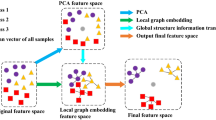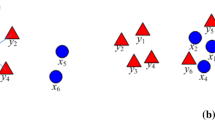Abstract
Complete neighborhood preserving embedding (CNPE) is an improvement to the neighborhood preserving embedding (NPE) algorithm, which can address the singularity and stability problems of NPE and at the same time preserve useful discriminative information. However, CNPE works with vectorized representations of data, and thus, the original 2D face image matrices should be previously transformed into the same dimensional vectors. Such a matrix-to-vector transform usually leads to a high-dimensional image vector space, which makes the eigenanalysis quite difficult and time-consuming. Beyond computational issues, some spatial structural information between nearby pixels may be lost after vectorization. In this paper, we develop a new scheme for image feature extraction, namely, two-dimensional complete neighborhood preserving embedding (2D-CNPE). 2D-CNPE builds the eigenmatrix and the weight matrix which characterize local neighborhood properties of data directly based on the original face images, and then, the optimal embedding axes are obtained by performing an eigen-decomposition. Experimental results on three face databases show that the proposed 2D-CNPE achieves better performance than other feature extraction methods, such as Eigenfaces, Fisherfaces, and 2D-PCA.







Similar content being viewed by others
References
Chellappa R, Sirohey S, Wilson CL, Barnes CS (1994) Human and machine recognition of faces: a survey. Technical Report CAR-TR-731, CS-TR-3339, University of Maryland
Zhao W, Chellappa R, Phillips PJ, Rosenfeld A (2003) Face recognition: a literature survey. ACM Comput Surv 35(4):399–459
Turk M, Pentland A (1991) Eigenfaces for recognition. J Cogn Neurosci 3(1):71–86
Donoho DL (2000) High-dimensional data analysis: the curses and blessings of dimensionality. http://www-stat.stanford.edu/~donoho/Lectures/AMS2000/Curses.pdf
Tenenbaum JB, de Silva V, Langford JC (2000) A global geometric framework for nonlinear dimensionality reduction. Science 290(5500):2323–2326
Belhumeur PN, Hespanha JP, Kriengman DJ (1997) Eigenfaces vs. fisherfaces: recognition using class specific linear projection. IEEE Trans Pattern Anal Mach Intell 19(7):711–720
He XF, Yan SC, Hu YX, Niyogi P, Zhang HJ (2005) Face recognition using Laplacianfaces. IEEE Trans Pattern Anal Mach Intell 27(3):328–340
Hotelling H (1933) Analysis of a complex of statistical variables into principal components. J Edu Psychol 24:417–441
Fisher RA (1936) The use of multiple measurements in taxonomic problems. Ann Eug 7:179–188
Fukunaga K (1990) Introduction to statistical pattern recognition. Academic Press, New York
He XF, Niyogi P (2003) Locality preserving projections. In: Proceedings of the conference on advances in neural information processing systems
Belkin M, Niyogi P (2001) Laplacian eigenmaps and spectral techniques for embedding and clustering. In: Proceedings of the conference on advances in neural information processing systems
He XF, Cai D, Yan SC, Zhang HJ (2005) Neighborhood preserving embedding. In: IEEE International conference on computer vision (ICCV), pp 1208–1213
Stewart GW (1973) Introduction to matrix computations. Academic Press, New York
Swets D, Weng J (1996) Using discriminant eigenfeatures for image retrieval. IEEE Trans Pattern Anal Mach Intell 18(8):831–836
Wang Y, Wu Y (2010) Complete neighborhood preserving embedding for face recognition. Pattern Recogn 43(3):1008–1015
Yang J, Zhang D, Frangi AF, Yang JY (2004) Two-dimensional PCA: a new approach to appearance-based face representation and recognition. IEEE Trans Pattern Anal Mach Intell 26(1):131–137
Li M, Yuan B (2005) 2D-LDA: a statistical linear discriminant analysis for image matrix. Pattern Recogn Lett 26(5):527–532
Xiong H, Swamy MNS, Ahmad MO (2005) Two-dimensional FLD for face recognition. Pattern Recogn 38(7):1121–1124
Chen S, Zhao H, Kong M, Luo B (2007) 2D-LPP: a two-dimensional extension of locality preserving projections. Neurocomputing 70:912–921
Hu D, Feng G, Zhou Z (2007) Two-dimensional locality preserving projections (2DLPP) with its application to palmprint recognition. Pattern Recogn 40:339–342
Roweis ST, Saul LK (2000) Nonlinear dimensionality reduction by locally linear embedding. Science 290(5500):2323–2326
Olivetti & Oracle Research Laboratory (1994) The Olivetti & Oracle Research Laboratory Face Database of Faces. http://www.cam-orl.co.uk/facedatabase.html
Yale Univ. (2002) Face Database. http://cvc.yale.edu/projects/yalefaces/yalefaces.html
Phillips PJ, Moon H, Rizvi SA, Rauss PJ (2000) The FERET evaluation methodology for face recognition algorithms. IEEE Trans Pattern Anal Mach Intell 22(10):1090–1104
Acknowledgments
The authors would like to thank the anonymous referees for their helpful comments and suggestions. The research described in this paper has been supported by the National Natural Science Foundation of China (Grant No. 60975038), Foundation of People’s Bank of China (Grant No. 2007L24-G4).
Author information
Authors and Affiliations
Corresponding author
Rights and permissions
About this article
Cite this article
Wang, Y., Xie, JB. & Wu, Y. Two-dimensional complete neighborhood preserving embedding. Neural Comput & Applic 24, 1505–1517 (2014). https://doi.org/10.1007/s00521-013-1365-3
Received:
Accepted:
Published:
Issue Date:
DOI: https://doi.org/10.1007/s00521-013-1365-3




